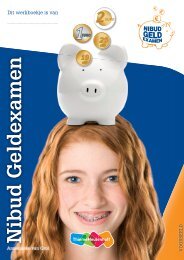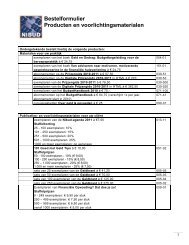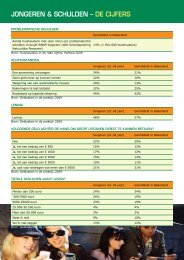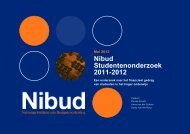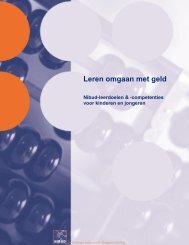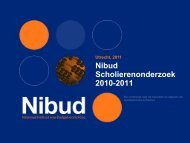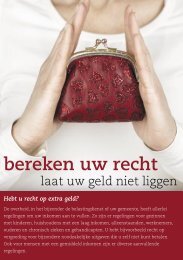1 A reference buffer for households A study of Dutch ... - Nibud
1 A reference buffer for households A study of Dutch ... - Nibud
1 A reference buffer for households A study of Dutch ... - Nibud
- No tags were found...
Create successful ePaper yourself
Turn your PDF publications into a flip-book with our unique Google optimized e-Paper software.
A <strong>reference</strong> <strong>buffer</strong> <strong>for</strong> <strong>households</strong>A <strong>study</strong> <strong>of</strong> <strong>Dutch</strong> <strong>households</strong>’ net wealth and saving patternsM. Warnaar, C. van Gaalen & A. van der Schors (<strong>Nibud</strong>, 2012)In 2008 the <strong>Dutch</strong> National Institute <strong>for</strong> Family Finance In<strong>for</strong>mation (<strong>Nibud</strong>) developed a BufferCalculator to give <strong>Dutch</strong> <strong>households</strong> a general idea <strong>of</strong> how much money similar <strong>households</strong> havein their savings accounts. The Buffer Calculator was based on 2006 figures. The recenteconomic crisis has probably changed <strong>households</strong>’ financial behaviour – a good reason torecalculate the <strong>reference</strong> amount <strong>for</strong> <strong>households</strong>’ savings accounts in the light <strong>of</strong> the most recentdata. Households’ saving patterns have also been examined.The <strong>study</strong> is based on three sets <strong>of</strong> data: the ING Bank’s Budget Barometer <strong>for</strong> the secondquarter <strong>of</strong> 2012, the 2011 Household Survey drawn up by the <strong>Dutch</strong> central bank (DNB), and thedata used <strong>for</strong> the <strong>study</strong> entitled Geldzaken in de praktijk (‘Dealing with money in practice’).Saving patternsThe largest group <strong>of</strong> <strong>households</strong> (some 40%) report that they save irregularly, i.e. only if theyhave money left over, or in varying amounts. About a quarter save a fixed amount each month.One household in seven does not save at all; these non-savers are mainly single people andlow-income <strong>households</strong>. Those that save a fixed amount set aside an average <strong>of</strong> 9% <strong>of</strong> theirincome each month.Reasons to saveReasons to save have three dimensions. The first dimension concerns the <strong>buffer</strong>, mainly in theshort and medium term; the main reasons here are being able to cope with un<strong>for</strong>eseenexpenditure, and avoiding dependence on other people. The second dimension concernswhether there are children in the household. The third dimension concerns one-<strong>of</strong>f majorexpenditure, such as buying a home or starting up a business. What is striking about the firstdimension is that the <strong>households</strong> involved have few features in common – maintaining a <strong>buffer</strong>appears to be a universal wish.Size <strong>of</strong> the <strong>buffer</strong>About 20% <strong>of</strong> <strong>households</strong> say they have no financial <strong>buffer</strong> at all; another 20% say they have a<strong>buffer</strong> <strong>of</strong> less than €2,000. Half <strong>of</strong> the people who say they find it hard to make ends meet reportthat they have no <strong>buffer</strong>.Some 85% <strong>of</strong> <strong>households</strong> would like to have a <strong>buffer</strong>. Only the lowest-income <strong>households</strong>, youngpeople under 25 and old people over 65 feel somewhat less <strong>of</strong> a need <strong>for</strong> one.Net wealthHowever, net wealth has increased considerably. Whereas in 2006 half <strong>of</strong> home-owners hadmore than €8,500 in savings accounts, by 2011 this figure had risen to €17,000.Net liquid wealth has also increased. These <strong>for</strong>m the basis <strong>for</strong> the <strong>reference</strong> <strong>buffer</strong>. They dependon age, the household’s income, whether the household owns its own home, the value <strong>of</strong> the carand whether there are children in the household.Households with a similar income save less and have a smaller <strong>buffer</strong> if they have children. Thecosts <strong>of</strong> children are so high that other spending is reduced, including the amounts that are setaside.1
Method <strong>for</strong> calculating the minimum <strong>buffer</strong> and the <strong>reference</strong> <strong>buffer</strong>Definition <strong>of</strong> the <strong>buffer</strong>We define the <strong>buffer</strong> as the amount <strong>of</strong> money that a household has immediately available tocover major expenditure arising unexpectedly at any time over the next ten years (medium -termcontingency expenditure). The main purpose <strong>of</strong> the <strong>buffer</strong> is to get through low-income or highexpendituremonths, to replace furniture and household goods, to maintain or replace the carand to maintain or decorate the home.That is why we use net liquid wealth as a basis <strong>for</strong> the <strong>reference</strong> <strong>buffer</strong>s. Liquid means that theassets can be quickly converted into money to pay <strong>for</strong> whatever is required. Net means thatallowance is made <strong>for</strong> any debts. If only possessions were considered, this would give a falsepicture <strong>of</strong> the household’s financial position.The <strong>reference</strong> <strong>buffer</strong> is thus not intended to absorb a drop in income due to such things asretirement, incapacity or unemployment. Nor is it intended to deal with emergencies that lead tomajor expenditure, such as fire or illness. In all such cases, insurance is a better alternative .The <strong>reference</strong> <strong>buffer</strong> is intended <strong>for</strong> the whole household, whether this consists <strong>of</strong> one person ormore than one. This is because the contingency expenditure that the <strong>buffer</strong> is intended to coveris <strong>of</strong>ten <strong>for</strong> the benefit <strong>of</strong> the whole household, rather than just one member <strong>of</strong> it.A larger <strong>buffer</strong> in times <strong>of</strong> uncertaintyThe current uncertainty have made many people spend less and invest less riskily. Fear <strong>of</strong> thefuture has probably led people to save more. Their expectations about their own financialsituation over the next twelve months have become much more pessimistic. Higher balances insavings accounts have raised median savings. This applies above all to middle- and high-income<strong>households</strong>, and those that own their homes.It is there<strong>for</strong>e fair to ask whether median net liquid wealth can still serve as the basis <strong>for</strong> therecommended <strong>buffer</strong>. On the one hand, balances in savings accounts will be larger than theyused to be so that furniture and household goods can be replaced. On the other hand, they are asign that people nowadays want to maintain a larger <strong>buffer</strong> than they used to. Because <strong>of</strong> thecrisis, it is likely that potential uses <strong>of</strong> the <strong>buffer</strong> have increased in recent years. People no longsave just to replace or repair furniture, household goods, the car or their home, but also becausethey are less certain about the future. A <strong>reference</strong> amount that fails to take account <strong>of</strong> thischange is bound to be unrealistic. Nor is it possible to itemise the amounts involved. Since hardlyanyone keeps separate savings accounts <strong>for</strong> the various types <strong>of</strong> contingency, it is impossible totell how much has been set aside <strong>for</strong> each specific purpose. We have there<strong>for</strong>e decided tocontinue using the median as the <strong>reference</strong> amount, while emphasising its referential nature(‘this is what similar <strong>households</strong> do’) rather than recommending it <strong>for</strong> the a<strong>for</strong>ementioned specificgoals.MeasurableWe want to devise a method <strong>of</strong> calculation that will allow people to fill in a number <strong>of</strong> particularsand then see what an appropriate <strong>buffer</strong> would be in their own situation. This will quickly makeclear to them how much money they should keep available <strong>for</strong> contingencies. They can thenquickly work out <strong>for</strong> themselves whether they already have enough or need to save more.Analysis shows that age, income, number <strong>of</strong> children, type <strong>of</strong> home (owner-occupied or rented)and value <strong>of</strong> the car affect the amount <strong>of</strong> net liquid wealth. These are all things that consumerseither know, or can easily find out.2
AcceptableThe <strong>reference</strong> <strong>buffer</strong> is estimated from empirical data. In many cases this model will provide afair estimate <strong>of</strong> <strong>households</strong>’ current net liquid wealth. However, this does not necessarily apply toall <strong>households</strong>. Especially in the case <strong>of</strong> low-income or very high-income <strong>households</strong>, the modelmay yield unrealistic results. For example, the <strong>reference</strong> amount <strong>for</strong> a <strong>buffer</strong> must never fallbelow zero. To prevent this, we have calculated a minimum <strong>buffer</strong> in addition to the estimated<strong>buffer</strong> based on empirical data. This will depend on the household’s situation rather than itsincome.Minimum <strong>buffer</strong>The minimum <strong>buffer</strong> is based on the minimum package <strong>of</strong> furniture and household goods drawnup by <strong>Nibud</strong>. It is there<strong>for</strong>e only intended <strong>for</strong> getting through low-income and high-expendituremonths, and <strong>for</strong> replacing essential furniture and household goods. This means it cannot be usedto finance such things as home maintenance or replacing the car.Just as in 2008, the minimum <strong>buffer</strong> is set at half the value <strong>of</strong> the package. If purchases arespread evenly over time, this is a fair approximation <strong>of</strong> the current value. This means that thedifference between the current value and the value <strong>of</strong> a new package will also be half. Thea<strong>for</strong>ementioned amount <strong>for</strong> furniture and household goods will be enough to get through low -income and high-expenditure months.Table 1: Minimum <strong>buffer</strong> (in euros)Minimum <strong>buffer</strong>Childless single person €3,550Childless couple €4,000Single parent with 1 child €3,950Single parent with 2 children €4,350Single parent with 3 children €4,950Single parent with 4 children €5,350Couple with 1 child €4,400Couple with 2 children €5,000Couple with 3 children €5,400Couple with 4 children €5,900Reference <strong>buffer</strong>The <strong>reference</strong> <strong>buffer</strong> indicates the amounts that similar <strong>households</strong> have in their savingaccounts. The size <strong>of</strong> the <strong>buffer</strong> is based on median, rather than average, net liquid wealth.Analysis shows that net liquid wealth does not have a Normal Distribution, and that the averageis not a reliable yardstick <strong>for</strong> most <strong>households</strong>. For example, median wealth is €30,000, whereasaverage wealth is over €47,000.For the purposes <strong>of</strong> analysis we assume a log-normal distribution <strong>of</strong> net wealth. In this way, wecan calculate the expected median.In estimating the model <strong>for</strong> the <strong>reference</strong> <strong>buffer</strong>, we have only included <strong>households</strong> with positivenet liquid wealth. This is because we want to <strong>of</strong>fer advice on how large the <strong>buffer</strong> should be.Households with positive net wealth have something they can use as a <strong>buffer</strong>. Those whose3
liabilities exceed their assets do not, and in that case nothing meaningful can be said about howlarge the <strong>buffer</strong> should be.We have decided to include all the <strong>households</strong> in the analysis, including over-65s. Including agelogarithmically reduces the effect <strong>of</strong> older respondents, but in any case the results would behardly any different if the over-65s were omitted.Realistic: a <strong>buffer</strong> that anyone can achieve and maintainThe model should result in a realistic <strong>buffer</strong> that any type <strong>of</strong> household should be able to achieveand maintain. We expect our method <strong>of</strong> calculation to yield a realistic <strong>buffer</strong> <strong>for</strong> every type <strong>of</strong>household, <strong>for</strong> it is based on empirical analysis <strong>of</strong> net wealth in the Netherlands, taking account<strong>of</strong> differing circumstances (see the ‘acceptable’ criterion). We have also considered media nrather than average net wealth. This ensures that the size <strong>of</strong> the <strong>buffer</strong> is not influenced by ahandful <strong>of</strong> <strong>households</strong> with very high net liquid wealth. According to the model, half <strong>of</strong> similar<strong>households</strong> would have this amount available as a <strong>buffer</strong>.This yields the following <strong>for</strong>mula <strong>for</strong> calculating the <strong>reference</strong> <strong>buffer</strong>:ln (<strong>reference</strong> <strong>buffer</strong>) = 0.303 - 0.873 (if owner-occupied home) - 1.746 (if rented home) + 1.023 xln (age) - 0.485 x ln (number <strong>of</strong> children + 1) + 0.912 x ln (disposable monthly income) + 0.028 xln (current value <strong>of</strong> car).Time-related: the <strong>buffer</strong> should always be in placeThe <strong>buffer</strong> is not restricted to a specific time – it should always be in place. Whenever it hasbeen used to cover contingency expenditure, or if the household’s situation has changed, the<strong>buffer</strong> must be topped up again as soon as possible. Changes in individual situations, such aschanges in income, moving house or divorce, may affect the size <strong>of</strong> the <strong>buffer</strong>.If the <strong>buffer</strong> is not yet in place, it will depend on the household’s financial situation how soon itcan be. Analysis <strong>of</strong> the current pattern <strong>of</strong> income and expenditure will also be needed todetermine how much money the household can actually save. <strong>Nibud</strong>’s Persoonlijk Budget Advies(‘Personal Budgeting Advice’) can be <strong>of</strong> great help here.4





